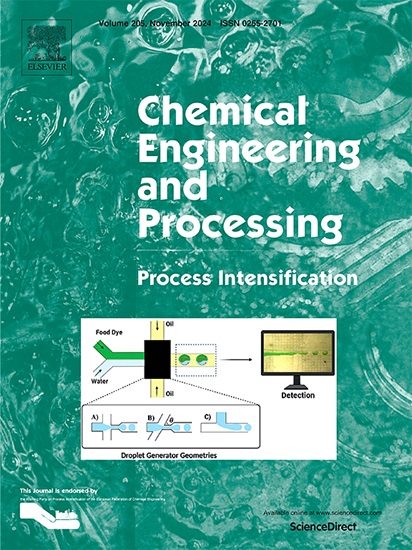用混合模型方法预测中试浓密机进料井的稀释和絮凝
IF 3.8
3区 工程技术
Q3 ENERGY & FUELS
Chemical Engineering and Processing - Process Intensification
Pub Date : 2025-05-15
DOI:10.1016/j.cep.2025.110364
引用次数: 0
摘要
稀释在絮凝过程中起着重要的作用,这取决于稀释口的结构和尺寸。考虑侧壁浸没长度(L)、弯管参考角(α)和长方体宽度(W)的交互影响,采用响应面法(RSM)和计算流体力学(CFD)的混合建模方法对稀释口进行优化。通过批量模拟试验,探讨了结构和尺寸对稀释量的影响。通过二次回归模型预测,最优进料井的自稀释水量为1.53 L/s,而基本情况为负1.32 L/s, α是影响稀释量最敏感的因素。随后,采用cfd -种群平衡耦合模型(PBM)方法比较了两种情况下的流动特性和絮凝性能。结果表明,根据预测的垂向絮凝体粒径变化规律,外井被划分为4个区。通过对进料井内及周围平均絮凝粒径分布的评价,优化后的混凝效果优于基本混凝效果,可指导进料井稀释口的设计,提高混凝效果。本文章由计算机程序翻译,如有差异,请以英文原文为准。

Dilution and flocculation prediction of a pilot-scale thickener feedwell by hybrid modelling approach
Dilution plays a significant role in the flocculation process, which relies on the structure and dimensions of the dilution port. The dilution port was optimized by the hybrid modelling approach between Response Surface Methodology (RSM) and Computational Fluid Dynamics (CFD), considering the interactive impact of sidewall immersion length (L), reference angle (α) to bending pipe, and width of the cuboid (W). Batch simulation tests were performed to explore the effect of structure and dimension on dilution quantity. A quadratic regression model forecasted the optimal feedwell would be capable of a self-diluting water volume of 1.53 L/s compared to the basic case of negative1.32 L/s, and the α was most sensitive factor that influence the dilution quantity. Subsequently, the flow characteristics and flocculation performance were compared between the two cases using the coupled CFD-Population Balance Model (PBM) approach. Results showed that the outer well was subdivided into four zones following the predicted variation of floc size along the vertical direction. The optimal case exhibited better flocculation performance than the basic case evaluated by the mean floc size distribution in and around the feedwell, thereby guiding the design of feedwell dilution ports for enhancing the flocculation performance.
求助全文
通过发布文献求助,成功后即可免费获取论文全文。
去求助
来源期刊
CiteScore
7.80
自引率
9.30%
发文量
408
审稿时长
49 days
期刊介绍:
Chemical Engineering and Processing: Process Intensification is intended for practicing researchers in industry and academia, working in the field of Process Engineering and related to the subject of Process Intensification.Articles published in the Journal demonstrate how novel discoveries, developments and theories in the field of Process Engineering and in particular Process Intensification may be used for analysis and design of innovative equipment and processing methods with substantially improved sustainability, efficiency and environmental performance.

 求助内容:
求助内容: 应助结果提醒方式:
应助结果提醒方式:


